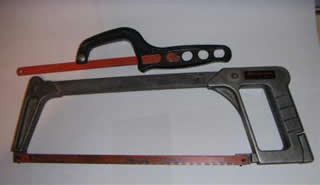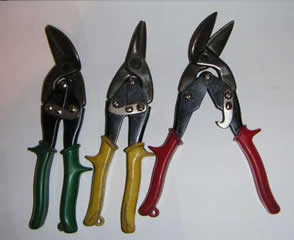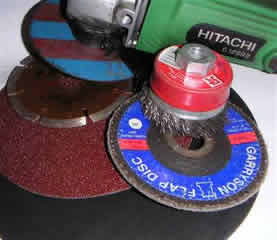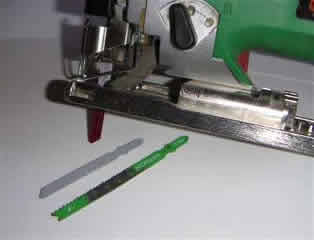There are a few different ways for the DIYer to cut metal. Here are the most available methods.

Hacksaws
Hacksaws are one of the most common methods. There are a few types, the most popular are adjustable frame, junior and blade holders. Great all purpose tool for cutting almost anything from screws to metal drainpipes.
The frame hacksaw accepts blades that are usually 12 inches long. Different tooth pitches are available, 18tpi, 24tpi and 36tpi. TPI stands for teeth per inch. The more teeth the blade has the more suited to cutting thinner metal sections it becomes. For larger sections choose a coarser blade. A good general purpose one to keep in your toolbox is a 24tpi.
As with all cutting tools a good quality one will make all the difference. Many frames will allow the blade to be rotated to 45 or 90 degrees, which allows cutting flash to a surface or clearing obstructions. These can be used for cutting virtually any metal.The junior hacksaw is a small saw, which is most suited to clean cutting on very small sections.The blade holder is a handy tool to have. Uses the same blades as a normal hacksaw frame.Great for cutting in confined spaces, they also allow the blade to be extended past the end of the holder to let you cut between two objects where you couldn’t use a normal saw. They will also accept broken blades as long as the portion you have remaining is long enough.
When choosing your blades try and get a quality bi-metal blade. They are much more flexible and will last well. When fitting to your frame or holder, ensure the teeth are pointing away from the handle. Often, blades will have a directional arrow reminding you of this. Use clamps or a vice to secure the object you want to cut. Use two hands, one to steady the frame and the other to push. Push down slightly on the forward stroke, don’t apply pressure as you draw it back. If you are not confident, wear a pair of gloves to protect your hands in case your saw slips off. Beware as the cut edges may become warm to the touch.

Snips and Shears
These are only suited to cutting thin sheet metal, usually up to about 1.2mm thick in steel.
Cutting stainless steel will lower the capacity to about 0.8/0.9mm and wear the blades more.
Can also be used for cutting some plastics. Aviation shears are very popular, three types are available, left hand cut, straight cut and right hand cut. Ideal for cutting curves. They are often colour coded, green is left, yellow is straight and red is right hand. The disadvantage of these is they will leave a slightly distorted edge which may require a small amount of cleaning up. The other type of snip have larger straight cutting jaws which are only suitable for cutting material up to a maximum of 1mm thick. Often referred to as ‘Gilbows’ which is a brand name. These however will leave a slightly cleaner cut.
Hand nibblers are another way of cutting sheet metal, again up to about 1.2mm thick. These remove a narrow strip of metal as the cut, rather than using a straight shearing action.
Angle grinders
Angle grinders can be a very versatile tool, great for cutting metal, wire brushing and grinding away metal, even wood carving! Also great for cutting masonry. However, they can be very dangerous in the wrong hands, and it is essential to wear goggles. They will make short work of most cutting jobs. The main limitation is you can only cut as far as the disc will reach. There are various sizes and types available, from 100mm to 350mm, the most common are 115mm (4.5”) and 230mm (9”)
For cutting, ensure you have selected a suitable cutting disc, most are designed for cutting steel. Specialist ones are available for cutting aluminium and stainless steel. Always follow the machines instructions on fitting the discs and using the grinder correctly. A standard cutting disc is 3mm thick but there are also thinner ones available from better tool suppliers. The thinner ones will put far less strain on your machine, create less sparks and give a quicker and cleaner cut. Never use a cutting disc for grinding or de-burring. Always make sure that what you are cutting will not fall away and grab the disc, this can cause it to break.

A small angle grinder fitted with thin metal cutting disc.
A few other types of disc are also pictured for various cutting and grinding jobs.
Jigsaws, Reciprocating saws and Circular saws
Jigsaws can be used to cut most metals as long as the thickness is within the capacity stated in the manual. It can be a noisy and slow task though. Lubricating the blade frequently is essential, as is selecting a good quality metal cutting blade. The same generally goes for reciprocating saws. Don’t run the machine at full speed as this will cause a lot of heat build up ruin the blade prematurely. A slow speed will be required. Your manual should give you an indication. If not start very slow, and slowly build up speed to a point where cutting is optimum. Recently circular saws capable of cutting metal have been introduced into the DIY market. These are very quick and produce a clean cut, but blades can be expensive. The blades are selected depending on what you need to cut, stainless steel, mild steel or aluminium. These special blades have tungsten carbide tips and run slower than a standard wood cutting circular saw. They must never be fitted to any other type of machine.
Goggles and ear protection are essential when using these.

Jigsaw fitted with standard metal cutting blade. The Green blade, is new type of blade a ‘progressor’ blade. They have teeth that increase in pitch as you go down the blade, making sure that you have the optimum number of teeth for what your cutting.
Other ways
There are many other ways to cut metal, depending on the job in hand. Material, accuracy and cost can affect the choice open to you. Other tools that can be used, but generally reserved for the professional or hire, are bandsaws, orbital tube cutters, cold cut chop saws, and a whole host of others! Some hand mitre saws can also be fitted with a blade that is suitable for cutting metal if accuracy is important.
If you have any questions just ask on the Ultimate Handyman Forum, a better option may be available.
Article written by Hitch



